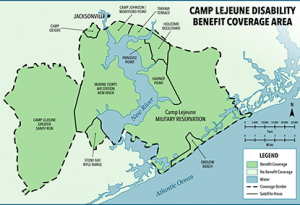Toxic and Contaminated Water Distribution at Camp Lejeune: Tarawa Terrace, Hadnot Point & Holcomb Boulevard
The Housing at Camp Lejeune had three primary supply and water distribution systems that serviced Camp Lejeune. These water distribution systems contained an assortment of wells, a treatment plant for the water and a water distribution system.
- Tarawa Terrace (beginning in 1952);
- Holcomb Boulevard (beginning June 1972); and
- Hadnot Point (beginning in 1942).

*This post was updated by an attorney on December 2nd, 2023 to provide victims the most up to date information about Camp Lejeune water contamination claims.
The history of Camp Lejeune water distribution systems
The history of Camp Lejeune water distribution systems indicates that Camp Lejeune’s drinking water “was extracted from over 100 water supply wells, treated at eight treatment plants, and distributed to its residents through a network of water distribution system pipelines” About lawsuits
Concentrations of water exceeded the maximum contaminant level (MCL) on the following dates for:
- Trichloroethylene (Present in water from: August 1953‐January 1985) (Maximum Level in 1989- 5 μg/L.)
- Tetrachloroethylene (Present in water from : August 1974‐January 1985) (Maximum Level of 3 μg/L in February 1985)
- Trans‐1,2‐dichloroethylene (Present in water from: November 1972‐January 1985) (Maximum Level of 33 μg/L in February 1985)
- Vinyl chloride (Present in water from: November 1972‐January 1985) ( Max level 6 μg/L during February 1985)
- Benzene (Present in water from :January 1979‐January 1985) (Maximum level of 12 μg/L during April 1984)
These contaminants of Camp Lejeune water supply systems existed in enough quantities that the water was hazardous to the life, health and welfare of people residing and working at the Marine base.
Circa 1955, chemicals that were toxic from numerous sources, specifically unlined landfills and storage tanks that were prone to leak slowly, seeped into the soil and groundwater of Camp Lejeune. This leaking contaminated numerous wells that were utilized to provide water to the water treatment plants.
United States Environmental Protection Agency (“EPA”) issued regulations
In 1979, the United States Environmental Protection Agency (“EPA”) issued regulations pertaining to water for drinking use pursuant to the Safe Drinking Water Act of 1974, 42 U.S.C. §§ 300f et seq. In order to be in compliance with these regulations / laws, the Camp Lejeune water authorities commenced testing drinking water at Camp Lejeune.
From the dates of December 1980 to March 1981, as part of the water sampling process, records proved that “water highly contaminated with other chlorinated hydrocarbons (solvents)”. In 1982, sampling established that the water for drinking at Hadnot Point plant and the Tarawa Terrance water treatment plant were polluted by volatile organic compounds much greater than safe levels.
Hadnot Point plant
The infamous Hadnot Point Water Treatment Plant at Camp lejeune commenced operations in the year of 1942. Hadnot Point delivered water to Hadnot Point and the Holcomb Boulevard service areas. The Hadnot Point water system was polluted / poisoned with TCE, PCE as well as refined petroleum products..
What were the major pollutants and contaminants at the base?
- tetrachloroethylene (also known as perchloroethylene or “PCE”),
- trichloroethylene (“TCE”),
- dichloroethylene,
- vinyl chloride and
- benzene
Various testing samples:
- 1982, the TCE level at Hadnot Point distribution system of Camp Lejeune was at a high of 1,400 parts per billion;
- PCE, vinyl chloride and benzene were found at the Hadnot Point distribution system after December 1984.
- July 1982 sampling of Tarawa Terrace distribution system- 104 parts per billion of TCE in the water.
- Early 1985, the TCE was as much as 1148 parts per billion.
- Dichloroethylene levels as great as 406 parts per billion in Berkeley Manor Elementary School area of Camp Lejeune;
- The PCE level was 215 parts per billion,
- A well providing water to Camp Lejeune had 18,900 parts per billion of TCE, 400 parts per billion of PCE, 8,070 parts per billion of dichloroethylene and 655 parts per billion of vinyl chloride.
Holcomb Boulevard Distribution Center
The Holcomb Boulevard Water Treatment plant came into existence in 1972. In addition to the Hadnot Point and Tarawa Terrace distribution systems, the Holcomb Boulevard distribution system was periodically polluted by Hadnot Point water between the years of 1972 and 1985. Before 1972, the Holcomb Boulevard area was provided with drinking water by the Hadnot Point system. The Holcomb Boulevard system was generally not polluted with the exception of intermittent transfers of contaminated water from the Hadnot Point Water System.
Tarawa Terrace water treatment plant
In 1952, the Navy built Tarawa Terrace subdivision and a water treatment plant. Unfortunately, the Tarawa water treatment plant and numerous wells were located down a gradient from established gas stations, automobile repair shops and dry cleaners. One year later, ABC One Hour Dry Cleaner opened directly across the street from Tarawa Terrace. ABC dry cleaners unleashed dry cleaning solvent into the ground. Sadly, these solvents contaminated the groundwater. As a result, the dry cleaner site was determined to be a Superfund site. The ABC dry cleaners leaked or discharged toxins into the surrounding areas.